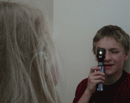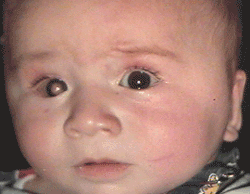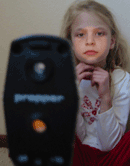Alaska Blind Child Discovery
Enhanced Bruckner Test
Home



Positive Bruckner reflex in the right eye
ABCD History

Kids Eye Disorders

Amblyopia
Vision Screening
Issues
ABCD Clinics
References
Contact ABCD


Bruckner described a different appearance of the red pupil reflex when the eye is not properly fixing. The Enhanced Bruckner Test (EBT) involves viewing the child with a direct ophthalmoscope set on "plano" or zero diopters from a distance of about 2-3 feet. The bright, large circle light is used to overlap both pupils while the child is encouraged to look directly at the direct ophthalmoscope in a dim room. Then the ophthalmoscope is swung from exposing one eye and then the other back-and-forth to observe for pupil reaction; if the retina or optic nerve is injured, that eye will have pupil dilation (Marcus Gunn Pupil) rather than constricting equally in both eyes. If only one eye is looking directly at the ophthalmoscope, the non-fixing eye will have a less-dark-red pupil reflex! Another Enhancement to the Bruckner Test is to view the patient with the observer's eye NOT through the eye piece of the ophthalmoscope, but instead over the top, and from the side; this resembles photoscreening and will generate a light crescent in the pupil of an eye that is not focused on the ophthalmoscope.
Children who have strabismic amblyopia only due to isolated small-angle, constant strabismus in the absence of signficant refractive error or prior large-angle strabismus are very rare! EBT is very useful for checking post-operative strabismus patients in terms of residual small-angle strabismus. In the primary care pediatric use, EBT will be most useful in detecting high and/or unequal refractive error. EBT should also be employed when parents observe a white reflex (leukocoria) in the pupil! The Rebiscan may allow automated detection of the microstrabismus identified by + Bruckner. If the eye is looking about 15 degrees opposite from the viewer/screener, then a whitish-reflex will appear from the bright reflection of the normal optic nerve (Am J Ophthalmol. 2003 May;135(5):709-11)
With experience, pediatricians may become very effective with the Enhanced Brückner Test, however pediatric residents were better able to detect anisometropia with MTI photoscreening than with Brückner Test. Pediatricians can yield very high Predictive Value Positive Screening with Enhanced Bruckner!
